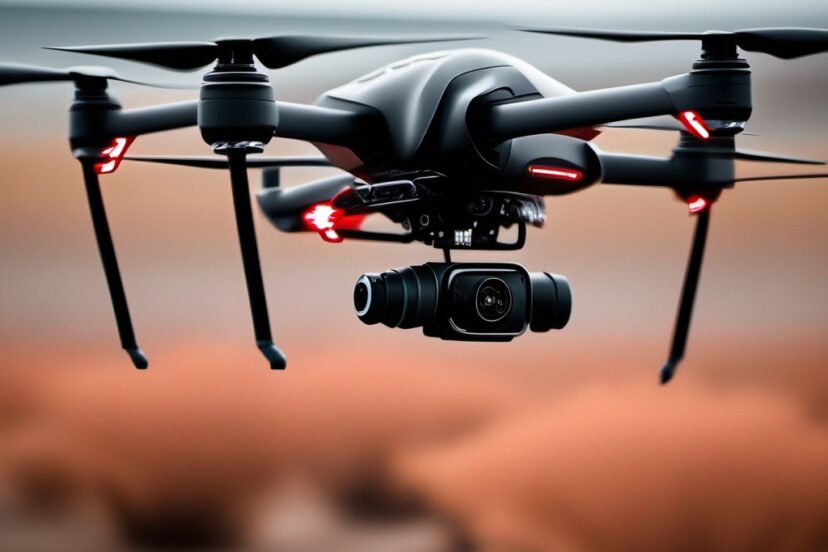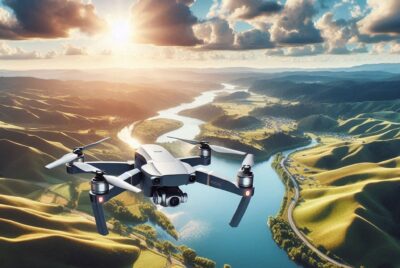Infrared Drone: Unveiling the Heat of Possibilities
*We may earn a commission for purchases made using our links. Please see our disclosure to learn more.
Infrared Drone: Revolutionizing Search and Rescue Operations
Infrared technology has revolutionized the way we see the world, particularly when it comes to unmanned aerial vehicles, or an infrared drone. These sophisticated devices are equipped with infrared cameras that enable them to detect heat signatures invisible to the naked eye. This capability makes them invaluable in a variety of applications including search and rescue missions, wildlife monitoring, and surveillance operations where visibility is hindered by darkness or obstructions.
Infrared drones come in various shapes and sizes, each designed to serve specific purposes. They are often deployed in situations that require thermal imaging, such as identifying heat loss in buildings, monitoring industrial equipment, or tracking the movement of people and animals. The infrared cameras mounted on these drones can capture high-resolution images and videos, providing crucial data that can be used to make informed decisions.
Critical factors to consider when selecting an infrared drone include the resolution and sensitivity of the thermal camera, the drone’s battery life, flight range, and the user interface of the control system. The thermal camera’s resolution will determine how detailed the thermal images will be, while its sensitivity will affect the device’s ability to detect minute temperature differences. An extended battery life and a far-reaching flight range will allow for lengthier missions and less frequent battery changes, increasing efficiency.
To address various needs and demands, my research and testing focus on a range of infrared drones, scrutinizing their capabilities and features to identify models that offer the best functionality and reliability. Selecting the right infrared drone is crucial for ensuring optimal performance in field operations. I’ve taken the time to analyze various models to assist you in finding an infrared drone that will deliver the results you need for any given application.
Top Infrared Drone Selections
In my extensive search for the ultimate infrared drones, I’ve come across a range of options that stand out for their advanced thermal imaging capabilities and exceptional performance. With thermal imaging becoming increasingly crucial for various applications—from search and rescue operations to wildlife monitoring and industrial inspections—selecting the right drone is paramount. The drones I’ve curated below boast some of the best infrared technologies in the market, ensuring precision and reliability in capturing heat signatures from the air.
Bwine F7 GPS Drone
I recently had the chance to test the Bwine F7 GPS Drone, and it’s a solid choice for adults seeking a versatile and long-lasting flying experience.
Pros
- Exceptional stability and control, even at high altitudes or in windy conditions
- Substantial flight time with the included three batteries
- Useful GPS features, including automatic return and follow-me mode
Cons
- A full battery charge requires several hours
- It might be less intuitive for absolute beginners despite the beginner mode
- Potential for technical difficulties or malfunctions over time, as with any sophisticated technology
Having hands-on experience with the Bwine F7 Drone’s night-vision capabilities and 4K camera, I found it delivers incredibly crisp and stable footage, thanks to its 3-axis gimbal. The camera’s zoom feature and wide FOV opened up a world of aerial photography opportunities for me, especially capturing the essence of nocturnal landscapes.
The 75-minute combined flight time from the three batteries allowed me to fly extensively without constant charging interruptions. I was able to enjoy longer flights, exploring without the nagging worry of a dying battery, which I consider a game-changer for any drone enthusiast.
Meanwhile, the dependable GPS system infused confidence during each flight. The drone’s ability to return home automatically when the battery runs low or when the signal drops is reassuring, particularly when exploring new or remote areas. Plus, the follow-me mode added a dynamic aspect to my videography, allowing me to be hands-free and still capture great content.
In summary, the Bwine F7 Drone seems like a reliable and high-performing option for the adult hobbyist or photographer looking to capture high-altitude perspectives and detailed night shots. Its extended flight time and GPS functions add to its allure, shaping it as a noteworthy competitor in the drone market.
TENSSENX TSRC Q7 Drone
For those in pursuit of capturing stellar aerial footage with ease, I find the TENSSENX TSRC Q7 to be a compelling choice.
Pros
- Seamless image capture thanks to 4K camera with stabilization
- Dependable flight with GPS assistance and smart return home feature
- Extended air time and portability with dual batteries and foldable design
Cons
- Requires an open environment for optimal GPS utilization
- Beginners may need time to master comprehensive features
- Limited customer service attention noted
Having just flown the TENSSENX TSRC Q7, I am quite taken with its 4K camera. The image stabilization really shines, producing crisp and stable footage that rivals more expensive models. I particularly enjoyed the unfettered freedom during flight, courtesy of the 5GHz ultra-fluent FPV transmission.
The GPS-assisted flight and intelligent return home function bring a reassuring peace of mind. It’s liberating to not fret over losing the drone as it dutifully returns at the touch of a button or when the battery runs low. Plotting paths and following them autonomously is a touch of brilliance, allowing for hands-off flight and focus on photography.
Dual batteries are a boon, delivering prolonged flight times that let me explore and film without the stress of a ticking clock. The foldable design coupled with a carrying case is a thoughtful touch. Also ensuring the drone is ready for adventures without a hassle. The convenience is undeniable, transforming from compact to flight-ready in mere moments.
Ruko F11PRO Infrared Drone
I’d recommend the Ruko F11PRO to anyone seeking a reliable and user-friendly infrared drone that offers a good balance of features for both beginners and seasoned enthusiasts.
Pros
- Long battery life of up to 60 minutes, enhancing flight experience
- Stable flight with level 6 wind resistance and straightforward controls
- High-quality 4K UHD camera with adjustable angles for excellent imagery
Cons
- The drone requires registration and a license in certain jurisdictions, adding extra steps before usage
- It lacks an included charger, necessitating an additional purchase
- Beginners may need time to interpret the comprehensive user manual
I recently got the opportunity to fly the Ruko F11PRO, and I must say, its FAA compliance feature instilled great confidence in flying it legally and safely. Observing the long flight time in action, it was quite impressive to have extensive air time without worrying about a quick landing to swap batteries.
The drone’s brushless motors delivered smooth and steady flight, even when gusts of wind tried to test its stability. That power and assurance make it accessible for pilots at any skill level. Also, the drone’s responsiveness to commands added to a seamless flying experience.
Capturing photos and videos with the 4K UHD camera was a breeze. The image quality was truly striking, and the adjustable angles allowed me to get creative with my shots. The GPS auto-return home function was a standout feature, adding a layer of safety by ensuring the drone returned to its takeoff point if it lost signal or ran low on battery.
In summary, flying the Ruko F11PRO was an enjoyable and trouble-free experience. The drone’s sturdy build, combined with its easy-to-use interface and premium camera, makes it a solid choice for anyone in the market for an infrared drone.
Holy Stone HS600
I recommend the Holy Stone HS600 for those seeking a capable and user-friendly drone experience with impressive camera stability and flight time.
Pros
- Exceptional flight stability with wind resistance and EIS
- Extended flight time of 56 minutes due to dual-battery setup
- GPS features enhance safety and user convenience
Cons
- Heavier than some mini-drones, potentially affecting portability
- Limited to two-axis gimbal rather than three-axis
- Range might be excessive for casual users
Having recently taken the Holy Stone HS600 for a spin, I was immediately taken by its sturdy flight performance. It’s clear that the integrated EIS and dual-axis gimbal work in tandem to deliver smooth, 4K quality footage, even when the drone battled against gusty winds. Capturing sharp stills from various heights and angles was a breeze, thanks to the reliable Sony sensor.
During the first flight, I was impressed by the extended 56-minute airtime, a feature seldom seen in drones at this price point. The dual batteries ensured I focused on my photography rather than worrying about a dwindling power supply. Moreover, monitoring the battery levels in real-time was straightforward, eliminating any guesswork about when to return.
What captivated me most was the drone’s return-to-home functions. The GPS accuracy of the Holy Stone HS600 provided peace of mind, as I was confident it would return safely when the battery ran low or if the signal was lost. For beginners, this is an invaluable feature that simplifies the learning curve dramatically.
Overall, the Holy Stone HS600 is an excellent choice for both budding and seasoned drone enthusiasts. Its blend of stability, clarity, and endurance make it a compelling option for a wide array of aerial photography tasks.
Infrared Drone: Buying Guide
Understanding Your Needs
When I look for an infrared drone, I first assess my specific needs. If my intention is to use it for professional surveillance, I might prioritize drones with long battery life and advanced thermal sensors. On the other hand, if I’m a hobbyist interested in wildlife photography at dusk, I would look for something with good camera resolution and easy maneuverability.
Key Features to Consider
Before making a purchase, I always check the following features:
- Camera Quality: The infrared camera’s resolution is crucial. Higher resolution means better image quality in low-light conditions.
- Flight Time: I look at how long the drone can stay in the air on a single charge. This is important for extended missions.
- Range: The distance the drone can cover without losing contact with the controller is a key factor for me.
- Durability: I select drones capable of withstanding various weather conditions.
- Ease of Use: Whether the drone is user-friendly or if it requires technical expertise influences my decision.
Comparing Specifications
I use a table to compare drones without getting overwhelmed by information:
| Feature | Specification | Why It Matters |
| Camera | x megapixels thermal resolution | Determines image clarity |
| Flight Time | x minutes | Affects operation duration |
| Range | x meters/kilometers | Impacts mission capabilities |
| Durability | Waterproof, wind resistance | Ensures reliability |
| Ease of Use | Automated flight modes, GPS, return | Simplifies operation |
Investment and Value
I balance my budget with the drone’s capabilities, ensuring I get the most value for my money. High-end features like automated tracking or object recognition might be worth the investment if they meet my requirements.
FAQs About Your Infrared Drone
1. What are the top features to look for in an infrared drone with a camera?
When selecting an infrared drone with a camera, key features to consider include thermal resolution, temperature range, flight time, camera integration with the flight system, and ease of use. High thermal resolution ensures better image clarity, and a wide temperature range allows for accurate detection of heat signatures in various environments.
2. How do infrared drones assist in search and rescue operations?
Infrared drones play a vital role in search and rescue by providing real-time thermal imagery that can detect heat signatures of humans and animals, especially in low-visibility conditions or at night. They can cover large areas quickly, improving the chances of locating missing persons and aiding in the coordination of rescue efforts.
3. What are the cost considerations when purchasing a drone with a thermal camera?
When investing in a drone with a thermal camera, consider the initial purchase price, the cost of additional sensors or cameras for specific needs, maintenance expenses, and the potential need for specialist training to operate the equipment effectively. Higher resolution and added features typically lead to higher costs.
4. Which drones are recommended for thermal imaging applications in wildlife tracking?
Drones like the DJI Matrice 300 RTK and the Parrot ANAFI Thermal are widely recommended for wildlife tracking. They offer high-resolution thermal cameras and a robust design suited for harsh environments. The ability to capture detailed images from a safe distance makes them particularly effective for studying wildlife without disturbance.
5. What are the legal implications of using infrared drones for surveillance?
The use of infrared drones for surveillance purposes is bound by local and federal privacy laws. Operators must adhere to regulations concerning data collection, respect no-fly zones, and often require consent when capturing thermal images in areas where individuals expect privacy. It is crucial to stay informed on the legal frameworks that govern the use of such technology in your jurisdiction.








